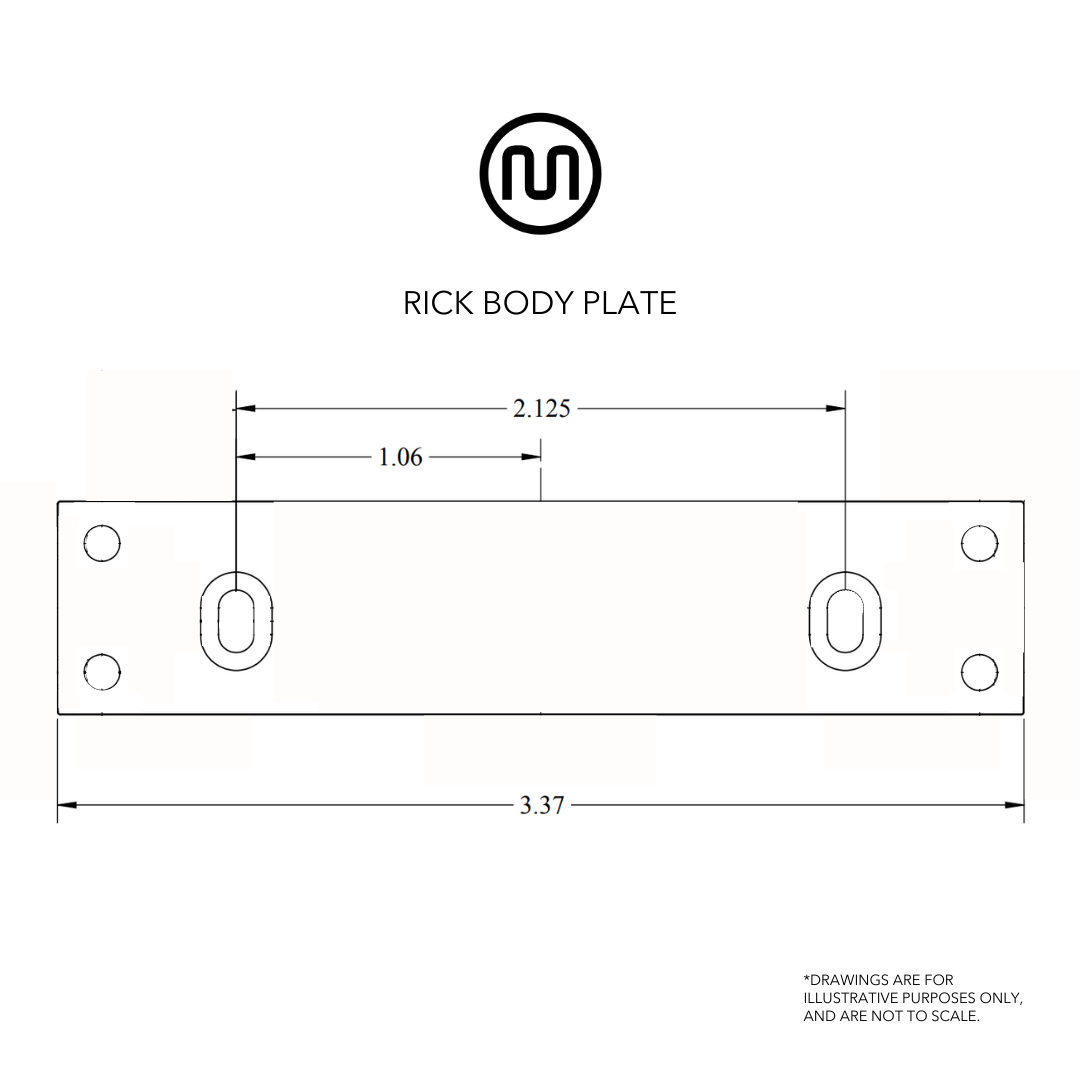Mastery Bridge Specifications
Our luthier designed and multi-patent issued bridges are crafted and assembled in Minneapolis, MN, using the finest materials available. Each individual bridge is inspected and tested before being shipped to you, to ensure the best possible performance. Every part of our bridge is precision machined out of the highest quality, non-corrosive materials to protect against any rust. Because we are currently such a small shop, Mastery hardware is only available through this website and is not available through any other online retailer in the USA. Please look over the descriptions of the various parts that go into the Mastery Bridge below.
Installation GuideMastery Saddles
The Mastery Bridge features a unique, patent issued two saddle design not found on any previous guitar bridge. On the 52mm string spacing from E to E, four intonation-adjustment screws are used instead of six, allowing the string to freely go from the saddle to the vibrato without any chance of interference from the front of an intonation screw or back of a baseplate. Each saddle features two drop-in swivels, permitting each of the individual intonation adjustment screws to work independently for precise intonation. The deep saddle string grooves ensure that your strings will never “pop-out” during performance and are slightly fanned out on each end. Instead of around 18 lbs. of string tension bearing down on an individual saddle as found on most bridges, our bridge applies over 50 lbs. of downward string tension on each saddle. This added tension per saddle forced downward transfers more string-to-body energy, which you’ll hear in your guitar acoustically as well as amplified. The saddles accommodate the heavy-gauge strings of Bass VI model guitars and can be used on left-handed guitars as easily as right-handed.
Adjustable
The Mastery Bridge features precisely curved adjustable saddles that allow you to effortlessly set-up to any common fingerboard radius, from 7.25″ onward. Although guitar manufacturers will CNC radius fingerboards to certain specs, it’s the top of the fret that matters and should be measured, and that can change/vary overtime due to slight unevenness and eventual playing wear. Different climactic conditions can move the wood of your neck and not the frets, and depending on how malleable your fretwire is it will move or not move with it, causing slight unevenness. Varying string thickness will also affect the top of the string radius; depending on the thickness of your strings you’ll want to adjust to them accordingly. Heavy-handed players also like our adjustable saddle design because they can easily raise the bass side of the strings slightly for hard-hitting. The saddles eliminate annoying “buzzing” or rattle associated with previous single saddle bridge designs. Adjustable radius bridge saddles like ours are important for slight tweaking on first install and in the long run.
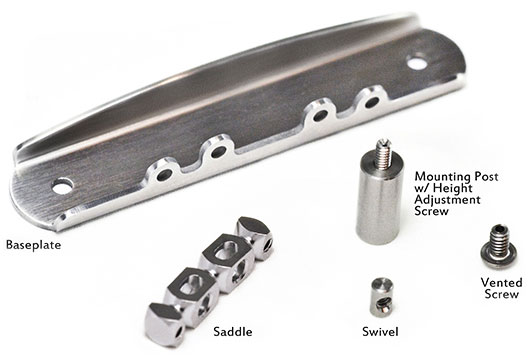
Swivels
Our patented two saddle design features two drop-in stainless steel swivels in each saddle, allowing each intonation adjustment screw to work independently from each other. We use a patented self-locking screw design for the socket head intonation screws that go into the swivels. Our four intonation screw design allows the strings to go freely from the saddle to the vibrato without any chance of interference from the front and back of an intonation screw or the back of a baseplate and makes intonation adjustments easy while the strings are up to tension.
Hard Chrome Plated Saddles
Plain brass, plain steel and plain stainless steel saddles eventually wear grooves into the saddle with vibrato use, which can cause muted tones and string breakage. Plain brass is the softest of these materials and can begin to wear within hours of vibrato use. The more surface area there is in a saddle groove, the more problems can arise later on. A steel string on an unfinished saddle naturally generates heat with heavy vibrato use, and that heat will expand the metal in your string and cause it to go out of tune. We use brass for our saddles, a softer, warmer-sounding metal, but plate them with a unique hard chrome plating not found on any other guitar bridge.
Hard chrome plating is commonly used to reduce friction and heat, along with increased wear resistance in parts like piston rings, firearms, airplane landing gear and bearing surfaces. It generates far less heat with vibrato use and your strings stay better in tune. Although much more expensive to manufacture than plain or “decorative chrome” saddles found on other bridges, our saddles’ unique hard chrome-plating aids in lubricity while tuning or actuating the vibrato of an Offset or Bigsby-equipped guitar, ensuring years of consistent performance and accuracy. No other bridge manufacturer uses plating this durable. Our saddles will remain the hardest surface on your guitar.
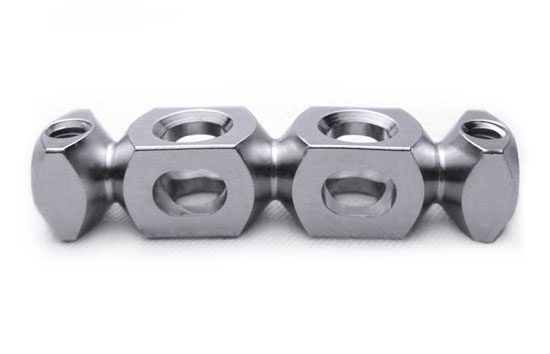
Offset Mounting Posts
Unlike the floating design found on all other offset-style bridges on the market, where the only metal-to-metal contact between the bridge and the body is on the bottom tip of two mounting post adjustment screws, the patented mounting post design of the Mastery Bridge fits snugly into the diameter of vintage thimbles, USA Fender-style thimbles (made prior to 2013), and perfectly into our own MT thimbles, which creates full contact between the bridge/thimble/body. This ensures your bridge will not change position during performance and remain stable during string changes without any chance of misalignment. Along with our unique saddle design, this feature also has a dramatic effect on the transfer of string-to-body energy, giving your guitar much greater resonance you’ll even hear acoustically.
Since the installation of the stock body thimbles can slightly vary from guitar-to-guitar, we’ve made our posts adjustable and removable via a vented 6-32 button head screw. The patented head screw contains a hole (the “vent”), allowing internal access to the adjustable bass/treble height screws. Like all other parts of the Mastery Bridge, the posts and screws are stainless and will not corrode.
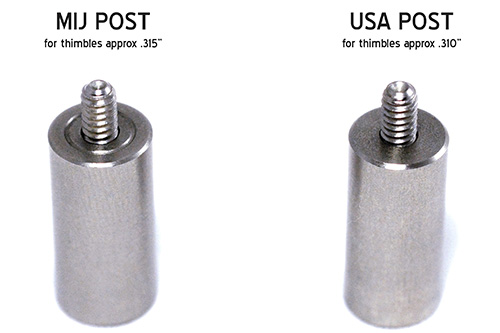
Offset Baseplate
Our patented designed baseplate is CNC water-cut from a solid, 304 stainless non-ferrous steel sheet. We then tumble them in a coarse media to de-burr and break any sharp edges. The plate edges are then buffed on a wheel and hand straight-line sanded. After bending them to the specified profile, our logo and batch numbers are laser printed into the metal. Our patented baseplate and saddle design prevents the string from making contact with the back end of the baseplate and front and back of the intonation screw on Offset and Bigsby equipped guitars.
Our M1 Mastery Bridge fits all new, used and vintage American made Fender guitars. Our M2 Mastery Bridge is the same bridge as our M1, but comes with an additional set of larger mounting posts required for most Japanese made guitars. Our M1 Offset mounting posts fit USA spec thimbles that have a .310″ inside diameter. Our M2 Offset mounting posts fit MIJ spec thimbles that have a .323″ inside diameter. If you’re unsure which Offset bridge you need, click HERE.
Tele Baseplate
Our Tele baseplate is CNC water-cut from a solid, 304 stainless non-ferrous steel sheet and stamped with our tooling to the specified profile. Our pickup cavity is undersized in tooling and then CNC’d to spec, thus eliminating any unwanted “flange” on the backside and creating a solid, flat surface. Each one is then hand sanded and tumbled to de-burr and break any sharp edges. Our logo is CNC engraved, followed by a series of hand straight-line sanding and media-blasting. The area above the pickup is buffed to a mirror finish. Our baseplates blend well aesthetically on both vintage and new guitars and are intended for Telecasters with a (4) hole vintage footprint. The Mastery M4.1 Bridge for Bigsby B5 users that have a standard vintage Tele footprint features cutouts in the back of the baseplate along with our unique hard chrome plated brass saddles to ensure your strings will glide smoothly over the surface of the saddles without any chance of interference or pinching in worn string grooves.
We do not make one-off tele bridges. For technical questions pertaining to the Mastery Bridge on your guitar, contact owner/luthier:
John Woodland: woody@masterybridge.com
Please note: We currently do not offer American Standard or other style baseplates for the Tele Mastery Bridge. We do not offer the Offset Bridge with plain brass saddles and do not sell saddles individually. Brass saddles on any bridge will succumb to string wear over time and our plain brass saddle option Tele bridge (M3) is not warrantied against this sort of natural wear.
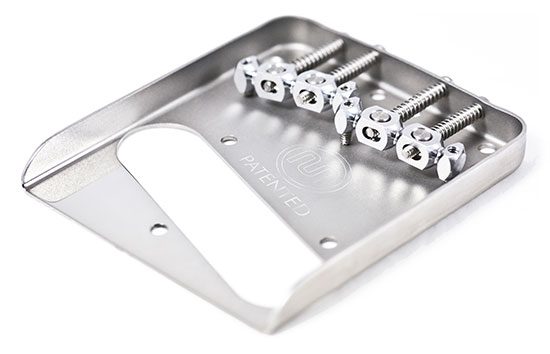
Tele Saddles
Our Tele saddles are the same as above, but with the bridge option of either electroplated brass saddles and swivels (M3 Bridge) or hard chrome-plated brass and stainless steel swivels (M4 Bridge).
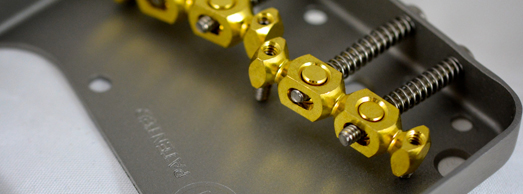
Mastery Bridge for Rickenbacker®
Our M5 Mastery Bridge for Rickenbacker® mounting post screws are made of 316 solid stainless steel and mount into the body-plate via two stainless cone point screws on each end of the plate, thus securing the baseplate to the body-plate. Posts won’t loosen during performance and the bridge will stay in place during string changes. Saddles are the same solid brass material as our other bridges and feature our unique hard-chrome plating. Baseplate and body-plate are hand straight-line sanded like our original offset bridge. Optional bridge cover is hand finished like the baseplate and blends well with existing hardware.
A .050″ Allen wrench adjusts both the saddle height adjustment screws and body-plate cone point screws. The 3/32″ Allen wrench adjusts both the mounting post screws and intonation screws (included). Our body-plate has a vintage footprint and no modifications to the guitar are required. String spacing on our M5 bridge is 48mm.
Like our other bridges all springs and screws are solid stainless steel and will not corrode.
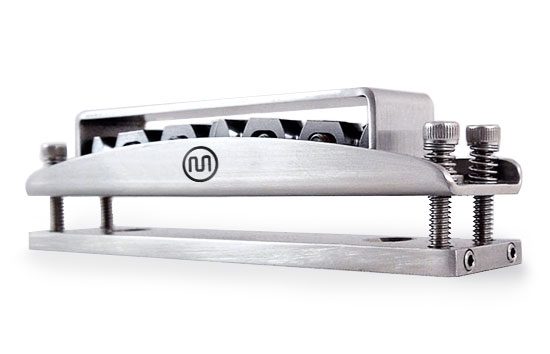
Vibrato Specs
FULL-CONTACT FULCRUM AND STRING PLATE
Our fulcrum plate and string plates are made of thicker stainless steel to ensure constant stability and both are machined to a knife edge after brake forming as brake forming metal can be inconsistent. Each string and fulcrum plate are tested together on each unit, to ensure the knife edge of the fulcrum plate makes full contact with the machined string plate. This results in an effortless, immediate fluttery response with use.
The internal fulcrum plate is secured by three flat head Phillips machine screws so your E strings will not rest against the top of the screws. Unlike vintage and other aftermarket offset trems, our body plate is thicker, not only to accommodate our flat head fulcrum plate screws, but to prevent warping over time, a common occurrence on vintage and thinner top offset vibratos.
STRING PLATE CUTOUT
The string plate cutout on the body plate is deeper to prevent the ball ends of your strings from touching the back end of the plate when the arm is moved upward. This also increases the upward dynamic range. The string plate cutout is wider to ensure the sides of the string plate don’t rest against the edges of the cutout. When stringing, adjust it centered and it will remain in place under tension.
VALVE SPRING
Our valve spring is custom made out of high carbon steel and is pre-set to remove stress and lessen any break-in period. High carbon steel is harder than stainless steel and better returns to its original shape despite significant bending. Our spring seat is machined from solid brass.
Turning the center Phillips machine screw on the body plate adjusts the tension of the spring and in doing so, the arm tension. Turn it clockwise to stiffen or counterclockwise to loosen to your preference. This will also lower and raise the arm off the body.
MASTERY ARM HOUSING
Mastery Vibratos feature our patent-pending arm housing that is machined from a single block of solid stainless steel and has an internal stainless steel spring plunger that allows you to adjust the stiffness of the vibrato’s arm rotation to your preference. The arm housing is threaded into our string plate and is secured by a custom made nut from the top, designed and machined by us. The arm itself is vintage-spec brake formed (not curved) with zero free play and has a threaded outer end with parchment tip included. The arm itself is machined from a hard, military-grade stainless steel alloy to prevent bending with use. No internal nylon plastic components are used.
Our arm and arm housing are preset from our factory to ensure zero free play, yet allow the arm to be moved freely and left in place when last used. It is recommended you do not remove the arm, even when cased, as we machine our arm housing to a close tolerance to our arms. It’s fine to remove to lubricate it if needed in the future.
We also machine arm tips out of aluminum, including our own “UFO” design, which are sold separately on our store page.
{OMV} Offset Mastery Vibrato models require no modifications to the guitar and will fit on every standard six wood-screw footprint. New, used, vintage and imported. (OMV, OMVL, OMV-P, OMVL-P).

{MV} Mastery Vibrato
{MV} Mastery Vibrato models have a custom shaped body plate and are for new builds only. These models are not intended for retrofitting on a standard Offset-style footprint. (MV, MVL, MV-P, MVL-P).
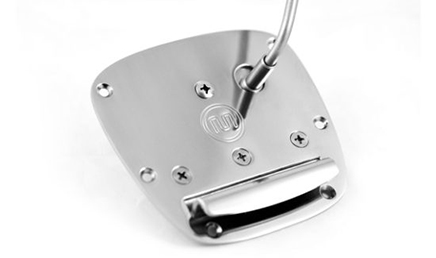
Tele and Hardtail Footprint Specs
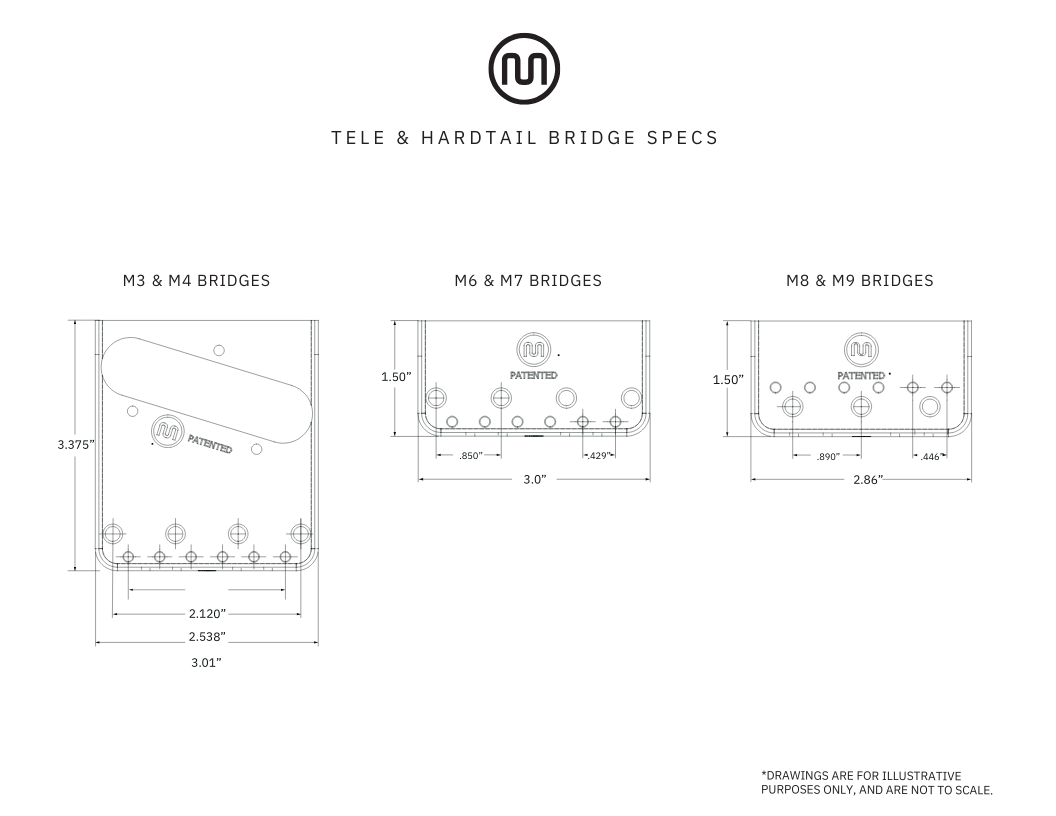
Rick Body Plate specs
